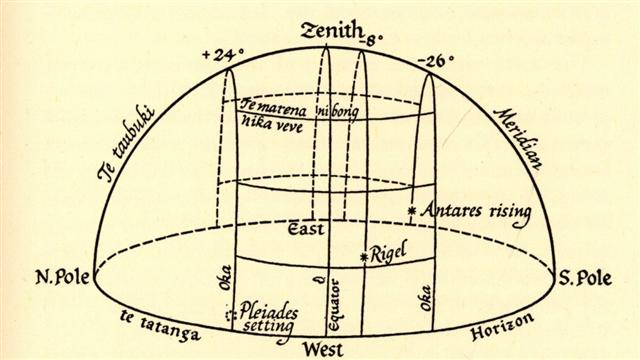Turning the tablet around from the top of side a to the bottom of side b ought to coincide with some important point in time. Side b is visible if the hole in the tablet is used for hanging it on a peg on the wall and the hole is far from line b1. The signs in the group with 5 * 3 = 15 glyphs at the end of line a14 and the beginning of line b1 appear to indicate a common 'denominator'. However, the last glyph on side a (Ca14-29) is drawn as only a 'fraction' of a complete glyph:
There are 2 honu glyphs at the beginning of this 15-group and a single central one (Cb1-2) at its end. In between are 2 Rogo glyphs plus a 'fake Rogo' (Ca14-22) with a dot in front. From Ca12-22 to Ca14-21 there are 46 days:
Evidently the front side of the Mamari text describes a leap year. This is the logical way to present the Gregorian calendar, because only when in a leap year the inserted extra day just has passed and adjusted for the effects of too short a normal calendar year can Sun time be considered as correct. Ca1-1 probably represents March 22 in a normal year and glyph 366 March 21 in a leap year:
Thus Cb1-1 could represent April 17 in a leap year, day 365 + 108 = 473. From February 29 to April 17 there are 108 - 31 (January) - 29 (February) = 48 days. The very special split glyph Ca14-21 seems to describe the day when 13 * 29½ = 383½. But this implies counting should begin with March 22. Perhaps the moon calendar is beginning 80 days later than the Gregorian calendar. Line b1 has 24 glyphs and line a1 has 26. This could be a Sign that the early morning Antares is ruling side a and the evening Pleiades is ruling side b.
However, another interpretation is to read line a1 as the last part of side b and line b1 as the last part of side a. 392 - 26 (a1) = 366. The hole between a1 and a2 could be a Sign. Beyond the first triplet in line b1 there are 7 glyphs which evidently should be read together:
Possibly my dates are irrelevant because the Gregorian calendar could end with day 472 (ordinary year) or day 473 (leap year) = April 16. I will anyhow extrapolate the Gregorian calendar to see where it leads us. The following 14 are the remaining glyphs in the line:
From maitaki at left in Ca12-22 to maitaki in Cb1-19 there 411 - 338 = 73 days. From maitaki at left in Ca12-22 to maitaki at left in Cb1-7 there are 399 - 338 = 61 days. 73 - 12 = 61, numbers alluding to the solar cycle. The united double nuku in Cb1-13 possibly means we from there onwards should count with 2 glyphs per day. 348 (number of glyphs on side b) - 12 = 336 and 336 / 2 = 168 = 24 weeks. 392 + 12 = 404 and 404 + 168 = 572 = 366 + 206. Counting side b to include also line a1 means adding 26 glyphs. 336 + 26 = 362 and 362 / 2 = 181 (equal to the distance from Aldebaran to Antares, the back side of the year as regarded from Easter Island). 404 - 26 = 378 (the synodic cycle of Saturn). 378 + 181 = 559 (= 13 * 43). We can compare with the first 11 lines on the H tablet which appear to have 558 glyphs, and 558 = 31 * 18. The figure in Cb1-21 is one of the unique glyphs in the Mamari text and with unknown meaning. But the vertical line is probably referring to 413 (= 14 * 29½):
Triplets of glyphs could be significant on side b. There are 29 glyphs from Ca14-21 to Cb1-21 and a dot in front in Ca14-22. In May 7 of a leap year the day number is 493 and 49 * 3 = 7 * 21. | ||||||||||||||||||||||||||||||||||||||||||||||||||||||||||||||||||||||||||||||||||||||||||||||||||||||||||||||||||||||||||||||||||||||||||||||||||||||||||||||||||||||||||||||||






















